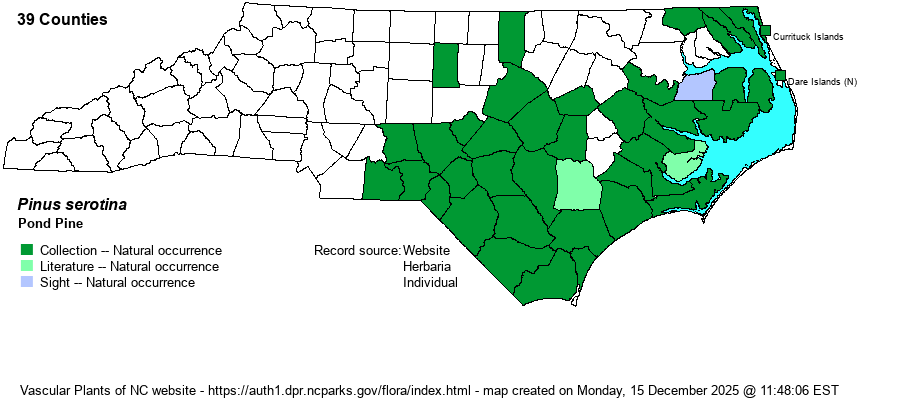| Author | Michaux | |
| Distribution | Essentially throughout the Coastal Plain, barely into the southeastern edge of the Piedmont, west at least to Granville, Wake, Montgomery, and Anson counties. There is a shortly disjunct specimen record from Alamance County in the cental Piedmont, if correct and of natural occurrence. Absent or very scarce in a few northwestern Coastal Plain counties.
A species of the Atlantic and Gulf Coastal Plains, ranging from southern NJ south to central FL and west to MS, essentially not in the Piedmont.
| |
| Abundance | Of local occurrence in the Coastal Plain, being common to locally abundant (and dominant) in some counties near the coast, from mainland Dare south to Brunswick. Farther inland, common in the Sandhills (along streams) and elsewhere in the southern Coastal Plain. Quite rare and locally absent in the northwestern quarter of the Coastal Plain. Very rare in the southeastern Piedmont and on the Outer Banks. | |
| Habitat | This species strongly favors acidic, peat-based soils, of pocosins (including Pond Pine Woodlands), steamheads in the Sandhills, and Carolina bays. It is the dominant tree in extensive pocosins and in peat-based Carolina bays, and it is often numerous along Sandhills blackwater streams. It also occurs in some savannas and flatwoods, where the soil is peat-based. |
| Phenology | Pollen is set in April, and normally develops mature cones in August. However, ripened seeds in the cones are often in response to fire, and thus the trees may not yield seed until a fire (and its heat) force the cones to open and scatter the seeds – no matter the time of year. | |
| Identification | This is a medium (to rarely large) tree, often with a somewhat crooked or “shaggy” appearance, growing to about 60-75 feet on average. The needles are fairly long, averaging 7 inches in length, and are usually in bundles of 3. These are the same dimensions and bundle number as the abundant Loblolly Pine (P. taeda), and the two are easily confused by inexperienced biologists. Pond Pines normally have somewhat twisted limbs, a shaggy look owing to needles growing in all directions, even along the trunk, and especially by the shorter and rounded cones, looking about the shape and size of a baseball (about 3 inches across) when opened, or a broad top when closed. Loblolly Pine has cones that are about twice as long as wide, and this is especially noticeable when the Loblolly cones are not fully opened with spreading scales. Both species often grow together, and thus they cannot be separated simply by habitat. However, Pond Pines typically grow in dense and solid stands in many pocosins, where Loblollies may be seen mainly along road margins and edges. | |
| Taxonomic Comments | None today, but a few older references included this species as a subspecies of Pitch Pine (P. rigida), and named as P. rigida ssp. serotina).
| |
| Other Common Name(s) | Pocosin Pine, Marsh Pine | |
| State Rank | S5 | |
| Global Rank | G5 | |
| State Status | | |
| US Status | | |
| USACE-agcp | FACW link |
| USACE-emp | OBL link |

